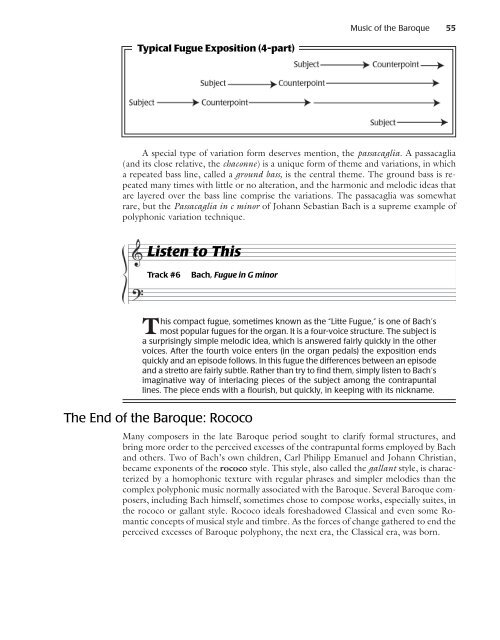Composer Profile - Activefolio
Composer Profile - Activefolio
Composer Profile - Activefolio
Create successful ePaper yourself
Turn your PDF publications into a flip-book with our unique Google optimized e-Paper software.
Typical Fugue Exposition (4-part)<br />
Music of the Baroque 55<br />
A special type of variation form deserves mention, the passacaglia. A passacaglia<br />
(and its close relative, the chaconne) is a unique form of theme and variations, in which<br />
a repeated bass line, called a ground bass, is the central theme. The ground bass is repeated<br />
many times with little or no alteration, and the harmonic and melodic ideas that<br />
are layered over the bass line comprise the variations. The passacaglia was somewhat<br />
rare, but the Passacaglia in c minor of Johann Sebastian Bach is a supreme example of<br />
polyphonic variation technique.<br />
Listen to This<br />
Track #6 Bach, Fugue in G minor<br />
This compact fugue, sometimes known as the “Litte Fugue,” is one of Bach’s<br />
most popular fugues for the organ. It is a four-voice structure. The subject is<br />
a surprisingly simple melodic idea, which is answered fairly quickly in the other<br />
voices. After the fourth voice enters (in the organ pedals) the exposition ends<br />
quickly and an episode follows. In this fugue the differences between an episode<br />
and a stretto are fairly subtle. Rather than try to find them, simply listen to Bach’s<br />
imaginative way of interlacing pieces of the subject among the contrapuntal<br />
lines. The piece ends with a flourish, but quickly, in keeping with its nickname.<br />
The End of the Baroque: Rococo<br />
Many composers in the late Baroque period sought to clarify formal structures, and<br />
bring more order to the perceived excesses of the contrapuntal forms employed by Bach<br />
and others. Two of Bach’s own children, Carl Philipp Emanuel and Johann Christian,<br />
became exponents of the rococo style. This style, also called the gallant style, is characterized<br />
by a homophonic texture with regular phrases and simpler melodies than the<br />
complex polyphonic music normally associated with the Baroque. Several Baroque composers,<br />
including Bach himself, sometimes chose to compose works, especially suites, in<br />
the rococo or gallant style. Rococo ideals foreshadowed Classical and even some Romantic<br />
concepts of musical style and timbre. As the forces of change gathered to end the<br />
perceived excesses of Baroque polyphony, the next era, the Classical era, was born.



